FIAT DUCATO 2006 3.G Service Manual
Manufacturer: FIAT, Model Year: 2006, Model line: DUCATO, Model: FIAT DUCATO 2006 3.GPages: 258, PDF Size: 4.05 MB
Page 41 of 258
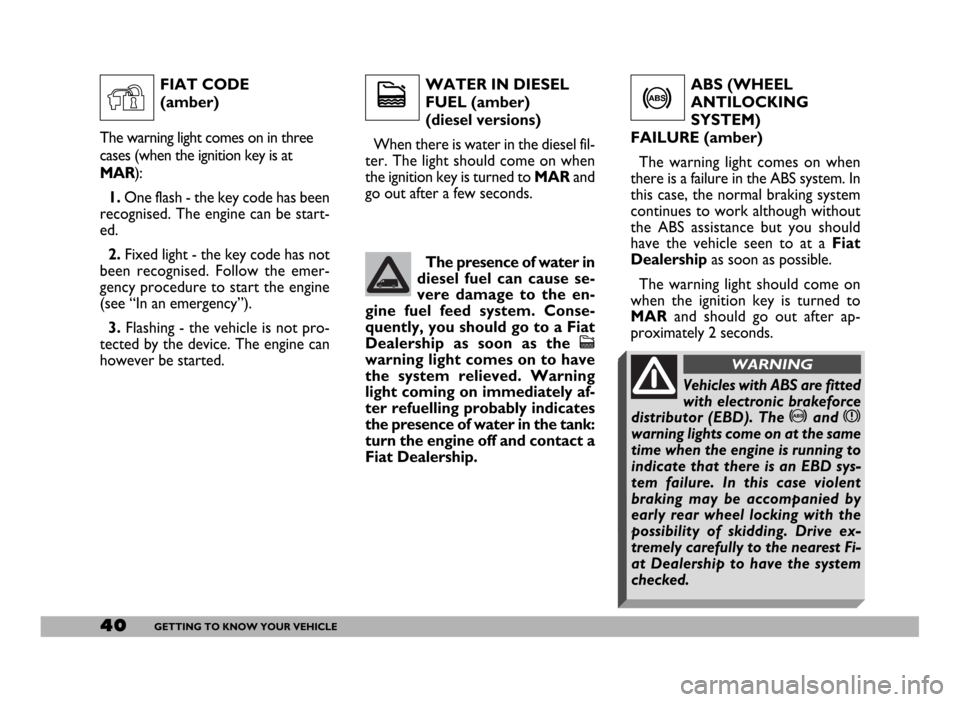
40GETTING TO KNOW YOUR VEHICLE
WATER IN DIESEL
FUEL (amber)
(diesel versions)
When there is water in the diesel fil-
ter. The light should come on when
the ignition key is turned to MAR and
go out after a few seconds.ABS (WHEEL
ANTILOCKING
SYSTEM)
FAILURE (amber)
The warning light comes on when
there is a failure in the ABS system. In
this case, the normal braking system
continues to work although without
the ABS assistance but you should
have the vehicle seen to at a Fiat
Dealershipas soon as possible.
The warning light should come on
when the ignition key is turned to
MARand should go out after ap-
proximately 2 seconds.
c
The presence of water in
diesel fuel can cause se-
vere damage to the en-
gine fuel feed system. Conse-
quently, you should go to a Fiat
Dealership as soon as the
c
warning light comes on to have
the system relieved. Warning
light coming on immediately af-
ter refuelling probably indicates
the presence of water in the tank:
turn the engine off and contact a
Fiat Dealership.
>
FIAT CODE
(amber)
The warning light comes on in three
cases (when the ignition key is at
MAR):
1.One flash - the key code has been
recognised. The engine can be start-
ed.
2.Fixed light - the key code has not
been recognised. Follow the emer-
gency procedure to start the engine
(see “In an emergency”).
3. Flashing - the vehicle is not pro-
tected by the device. The engine can
however be started.
Y
Vehicles with ABS are fitted
with electronic brakeforce
distributor (EBD). The >and x
warning lights come on at the same
time when the engine is running to
indicate that there is an EBD sys-
tem failure. In this case violent
braking may be accompanied by
early rear wheel locking with the
possibility of skidding. Drive ex-
tremely carefully to the nearest Fi-
at Dealership to have the system
checked.
WARNING
Page 42 of 258
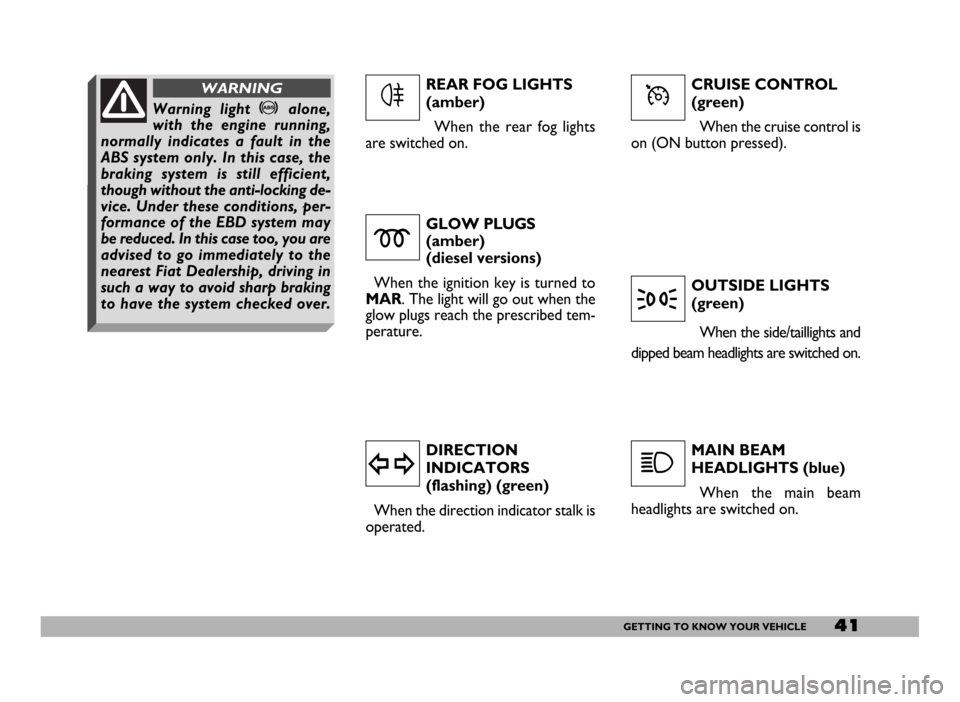
41GETTING TO KNOW YOUR VEHICLE
CRUISE CONTROL
(green)
When the cruise control is
on (ON button pressed).
GLOW PLUGS
(amber)
(diesel versions)
When the ignition key is turned to
MAR. The light will go out when the
glow plugs reach the prescribed tem-
perature.
DIRECTION
INDICATORS
(flashing) (green)
When the direction indicator stalk is
operated.OUTSIDE LIGHTS
(green)
When the side/taillights and
dipped beam headlights are switched on.
MAIN BEAM
HEADLIGHTS (blue)
When the main beam
headlights are switched on.
m
y
3
1
REAR FOG LIGHTS
(amber)
When the rear fog lights
are switched on.
4ÜWarning light >alone,
with the engine running,
normally indicates a fault in the
ABS system only. In this case, the
braking system is still efficient,
though without the anti-locking de-
vice. Under these conditions, per-
formance of the EBD system may
be reduced. In this case too, you are
advised to go immediately to the
nearest Fiat Dealership, driving in
such a way to avoid sharp braking
to have the system checked over.
WARNING
Page 43 of 258

42GETTING TO KNOW YOUR VEHICLE
Height adjustment
To raise the seat: move lever B-
fig. 46 (front seat part) or lever D-fig.
47(rear seat part) upwards and unload
your weight on the seat part to be
raised.
To lower the seat: move lever B
(front seat part) or lever D(rear seat
part) upwards and load your weight on
the seat part to be lowered.
Adjusting the reclining seat back
Turn knob C-fig. 47.
fig. 47
F0D0046m
INDIVIDUAL
SETTINGS
FRONT SEATS
Moving the seat backwards
or forwards
Lift lever A-fig. 46and push the seat
backwards or forwards.
fig. 46
F0D0045m
Only make adjustments
when the vehicle is sta-
tionary.
WARNING
Once you have released the
lever, check that the seat is
firmly locked in the runners by try-
ing to move it back and forth.
Failure to lock the seat in place
could result in the seat moving sud-
denly and dangerously.
WARNING
Page 44 of 258

43GETTING TO KNOW YOUR VEHICLE
E
fig. 48
F0D0104m
Lumbar adjustment
This feature ensures better back sup-
port.
To adjust, turn the knob E-fig. 48.
Driver’s seat warming
Press button A-fig. 49under the dri-
ver’s seat (next to handbrake lever) to
turn the seat warming off.SEAT WITH SHOCK
ABSORBER fig. 50
This seat features suspension with
mechanical springing system and hy-
draulic shock absorbers to guarantee
top comfort and safety since the
springing system enables to absorb any
shock due to bad surface roads.
This seat is fitted with height-ad-
justable armrest and head restraint.
See previous paragraph “Front seats”
for moving the seat backwards or for-
wards and for height, seat back, lum-
bar and armrest adjustment.Setting seat shock
absorbers/weight
Use the adjusting knob A-fig. 50to
set the required adjustment according
to your weight, settings range between
40 kg and 130 kg.
fig. 49
F0D0274m
F0D0279m
fig. 50
Page 45 of 258
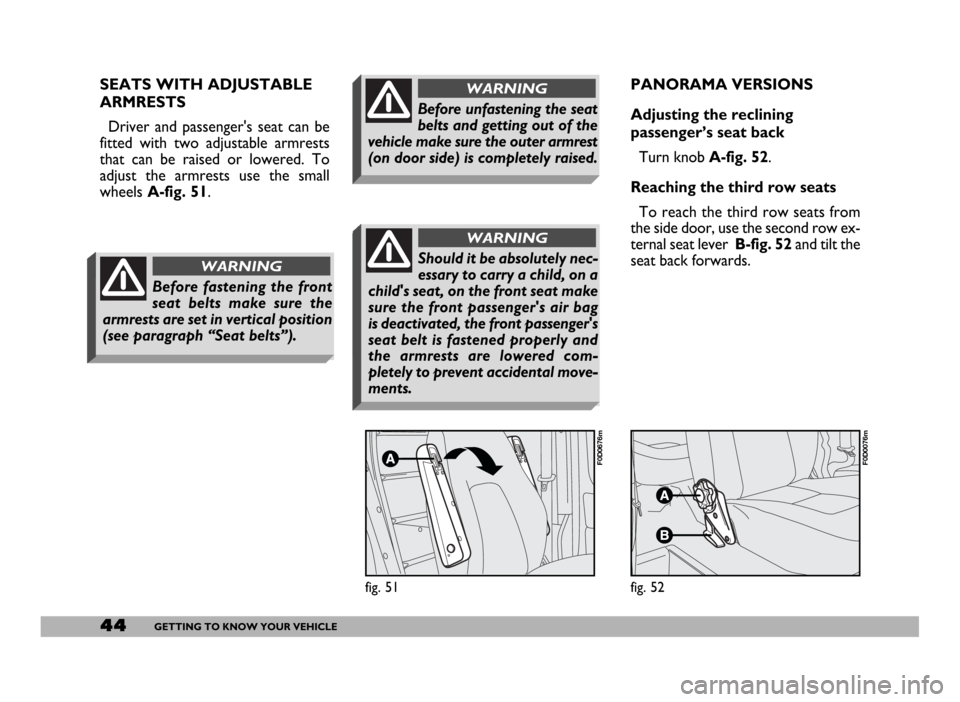
44GETTING TO KNOW YOUR VEHICLE
PANORAMA VERSIONS
Adjusting the reclining
passenger’s seat back
Turn knobA-fig. 52.
Reaching the third row seats
To reach the third row seats from
the side door, use the second row ex-
ternal seat lever B-fig. 52and tilt the
seat back forwards.
fig. 52
F0D0076m
SEATS WITH ADJUSTABLE
ARMRESTS
Driver and passenger's seat can be
fitted with two adjustable armrests
that can be raised or lowered. To
adjust the armrests use the small
wheels A-fig. 51.
fig. 51
F0D0676m
Should it be absolutely nec-
essary to carry a child, on a
child's seat, on the front seat make
sure the front passenger's air bag
is deactivated, the front passenger's
seat belt is fastened properly and
the armrests are lowered com-
pletely to prevent accidental move-
ments.
WARNING
Before fastening the front
seat belts make sure the
armrests are set in vertical position
(see paragraph “Seat belts”).
WARNING
Before unfastening the seat
belts and getting out of the
vehicle make sure the outer armrest
(on door side) is completely raised.
WARNING
Page 46 of 258
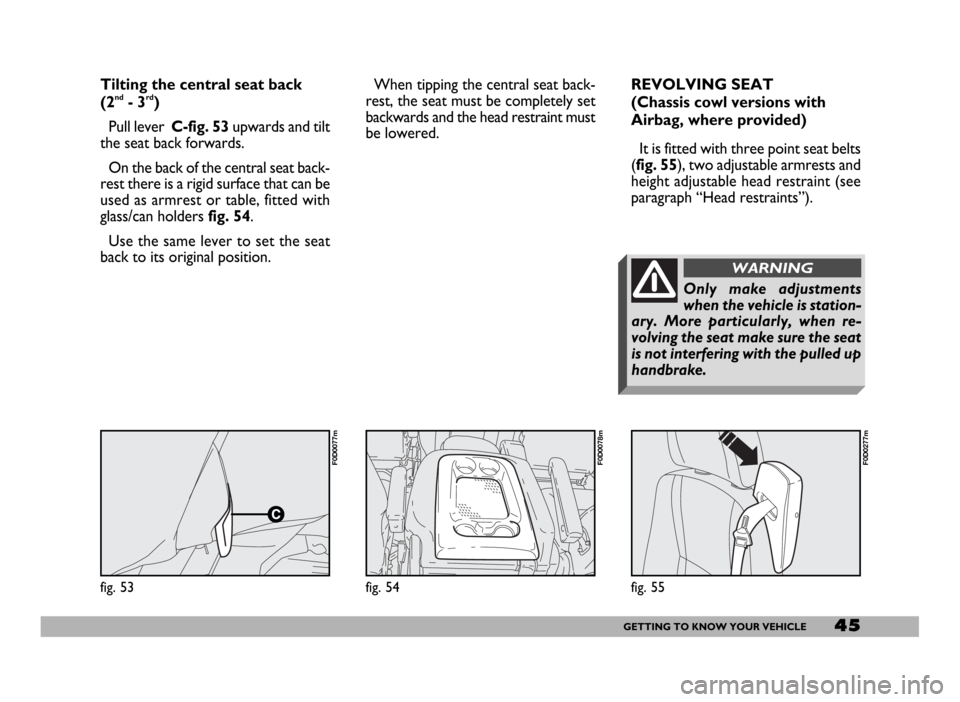
45GETTING TO KNOW YOUR VEHICLE
fig. 53
F0D0077m
Tilting the central seat back
(2nd- 3rd)
Pull lever C-fig. 53upwards and tilt
the seat back forwards.
On the back of the central seat back-
rest there is a rigid surface that can be
used as armrest or table, fitted with
glass/can holders fig. 54.
Use the same lever to set the seat
back to its original position.
fig. 54
F0D0078m
When tipping the central seat back-
rest, the seat must be completely set
backwards and the head restraint must
be lowered.REVOLVING SEAT
(Chassis cowl versions with
Airbag, where provided)
It is fitted with three point seat belts
(fig. 55), two adjustable armrests and
height adjustable head restraint (see
paragraph “Head restraints”).
Only make adjustments
when the vehicle is station-
ary. More particularly, when re-
volving the seat make sure the seat
is not interfering with the pulled up
handbrake.
WARNING
fig. 55
F0D0277m
Page 47 of 258
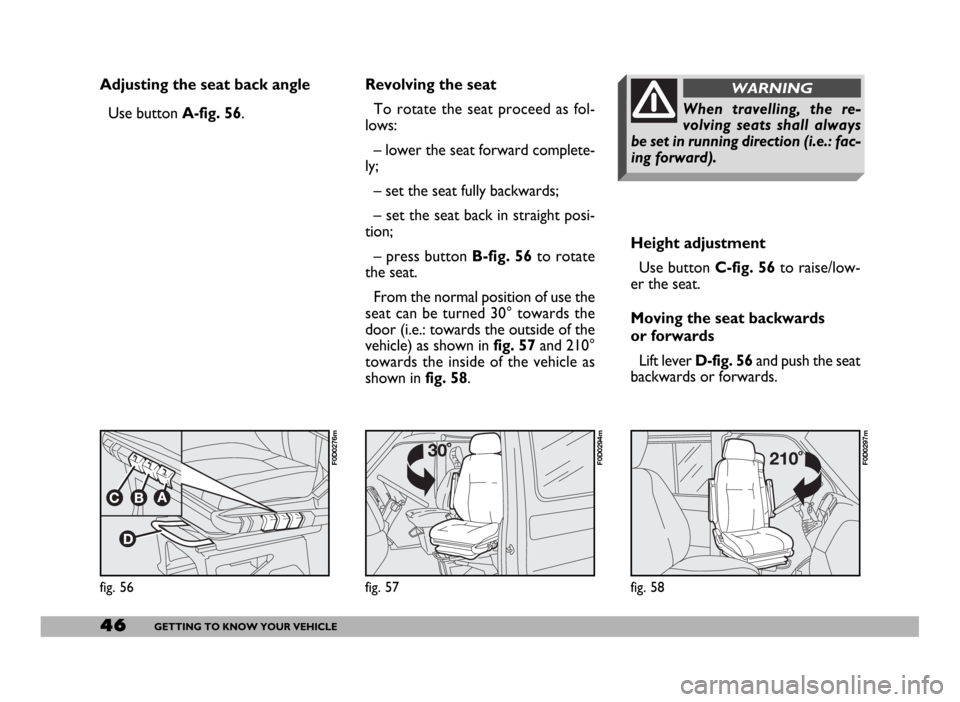
46GETTING TO KNOW YOUR VEHICLE
Adjusting the seat back angle
Use button A-fig. 56.
Height adjustment
Use button C-fig. 56to raise/low-
er the seat.
Moving the seat backwards
or forwards
Lift lever D-fig. 56and push the seat
backwards or forwards.
fig. 56
F0D0276m
Revolving the seat
To rotate the seat proceed as fol-
lows:
– lower the seat forward complete-
ly;
– set the seat fully backwards;
– set the seat back in straight posi-
tion;
– press button B-fig. 56to rotate
the seat.
From the normal position of use the
seat can be turned 30° towards the
door (i.e.: towards the outside of the
vehicle) as shown in fig. 57and 210°
towards the inside of the vehicle as
shown in fig. 58.
fig. 57
F0D0294m
fig. 58
F0D0297m
When travelling, the re-
volving seats shall always
be set in running direction (i.e.: fac-
ing forward).
WARNING
Page 48 of 258
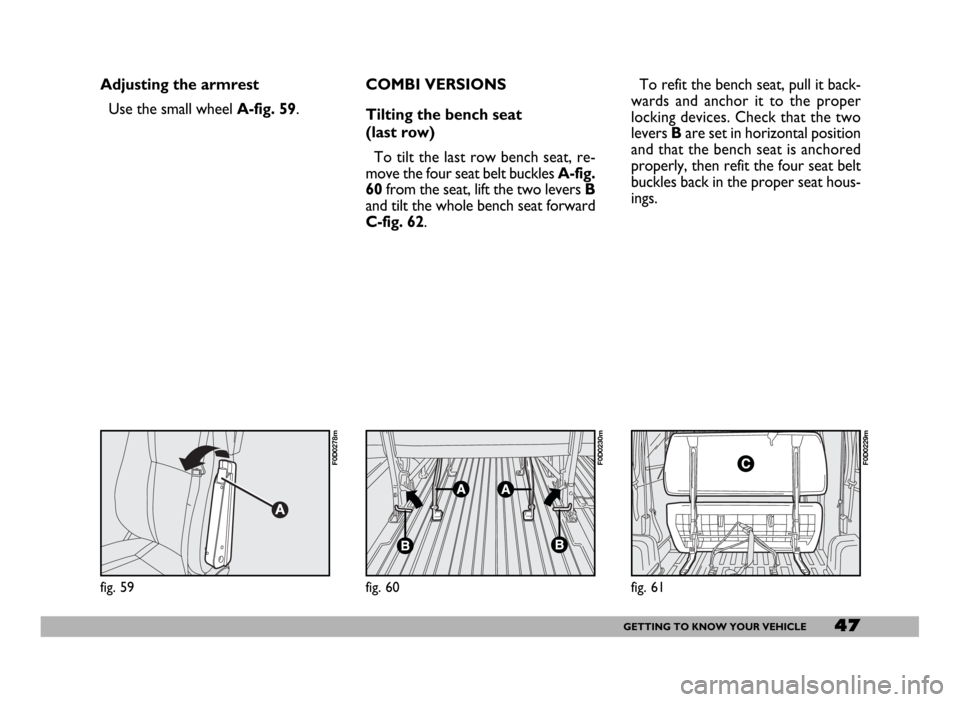
47GETTING TO KNOW YOUR VEHICLE
Adjusting the armrest
Use the small wheel A-fig. 59.
fig. 61
F0D0229m
fig. 60
F0D0230m
fig. 59
F0D0278m
COMBI VERSIONS
Tilting the bench seat
(last row)
To tilt the last row bench seat, re-
move the four seat belt buckles A-fig.
60from the seat, lift the two levers B
and tilt the whole bench seat forward
C-fig. 62.To refit the bench seat, pull it back-
wards and anchor it to the proper
locking devices. Check that the two
levers Bare set in horizontal position
and that the bench seat is anchored
properly, then refit the four seat belt
buckles back in the proper seat hous-
ings.
Page 49 of 258
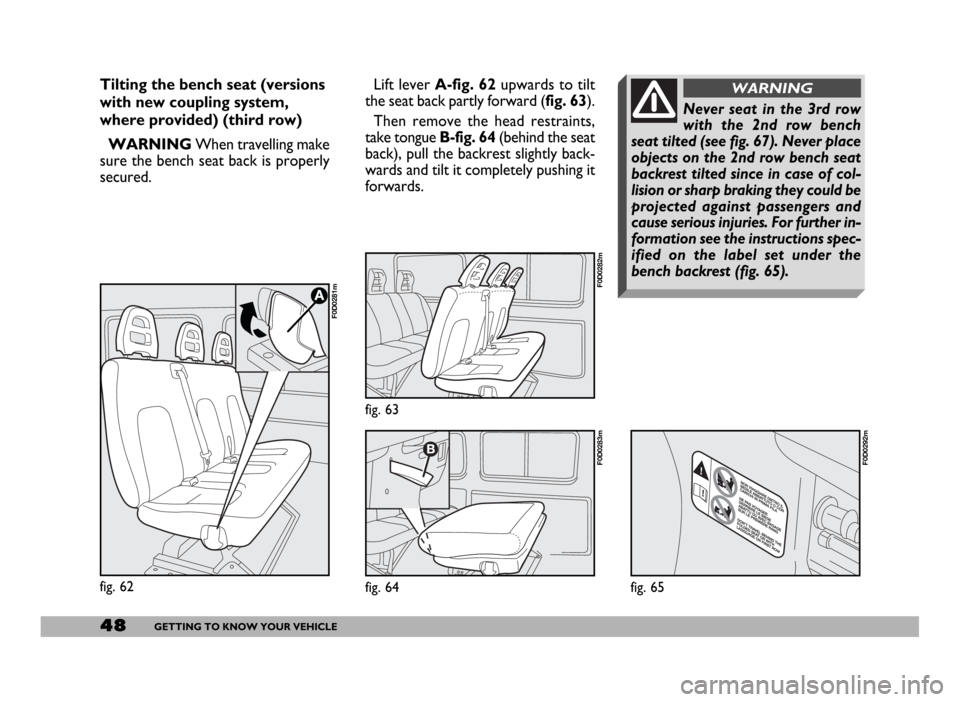
Lift lever A-fig. 62upwards to tilt
the seat back partly forward (fig. 63).
Then remove the head restraints,
take tongue B-fig. 64(behind the seat
back), pull the backrest slightly back-
wards and tilt it completely pushing it
forwards.
fig. 63
F0D0282m
fig. 64
F0D0283m
48GETTING TO KNOW YOUR VEHICLE
fig. 62
F0D0281m
Tilting the bench seat (versions
with new coupling system,
where provided) (third row)
WARNINGWhen travelling make
sure the bench seat back is properly
secured.
fig. 65
F0D0292m
Never seat in the 3rd row
with the 2nd row bench
seat tilted (see fig. 67). Never place
objects on the 2nd row bench seat
backrest tilted since in case of col-
lision or sharp braking they could be
projected against passengers and
cause serious injuries. For further in-
formation see the instructions spec-
ified on the label set under the
bench backrest (fig. 65).
WARNING
Page 50 of 258
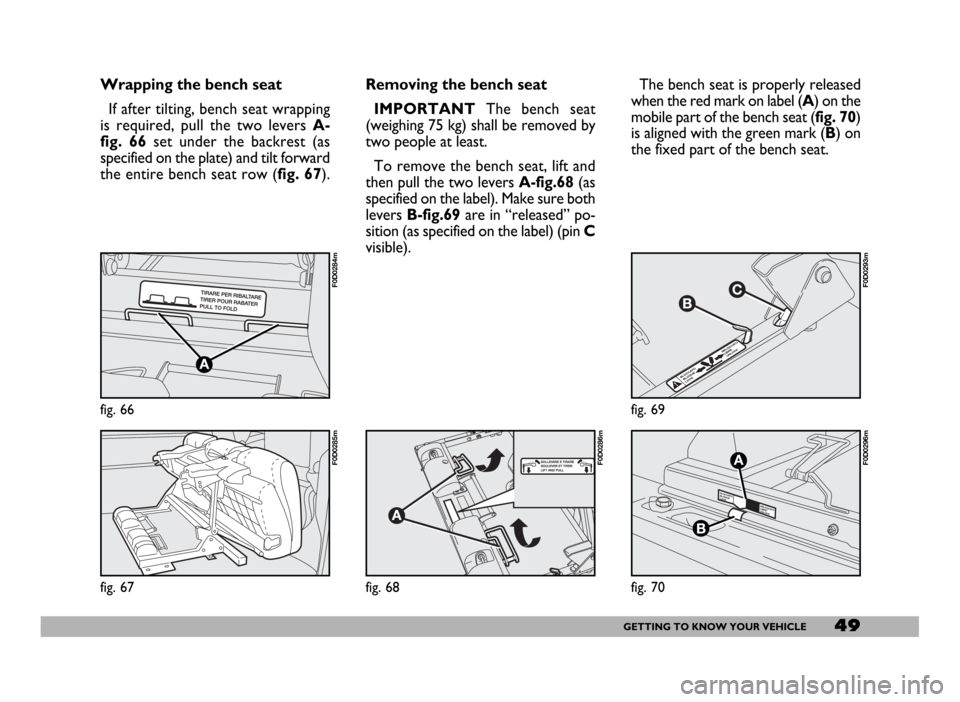
49GETTING TO KNOW YOUR VEHICLE
Wrapping the bench seat
If after tilting, bench seat wrapping
is required, pull the two levers A-
fig. 66set under the backrest (as
specified on the plate) and tilt forward
the entire bench seat row (fig. 67).
fig. 66
F0D0284m
fig. 67
F0D0285m
Removing the bench seat
IMPORTANTThe bench seat
(weighing 75 kg) shall be removed by
two people at least.
To remove the bench seat, lift and
then pull the two levers A-fig.68(as
specified on the label). Make sure both
levers B-fig.69are in “released” po-
sition (as specified on the label) (pin C
visible).The bench seat is properly released
when the red mark on label (A) on the
mobile part of the bench seat (fig. 70)
is aligned with the green mark (B) on
the fixed part of the bench seat.
fig. 68
F0D0286m
fig. 69
F0D0293m
fig. 70
F0D0296m